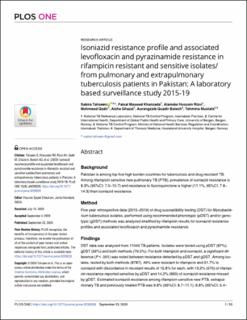Isoniazid resistance profile and associated levofloxacin and pyrazinamide resistance in rifampicin resistant and sensitive isolates/ from pulmonary and extrapulmonary tuberculosis patients in Pakistan: A laboratory based surveillance study 2015-19
Tahseen, Sabira; Khanzada, Faisal Masood; Rizvi, Alamdar Hussain; Qadir, Mahmood; Ghazal, Aisha; Baloch, Aurangzaib Quadir; Mustafa, Tehmina
Journal article, Peer reviewed
Published version

Åpne
Permanent lenke
https://hdl.handle.net/11250/2754908Utgivelsesdato
2020Metadata
Vis full innførselSamlinger
Sammendrag
Background
Pakistan is among top five high burden countries for tuberculosis and drug resistant TB. Among rifampicin sensitive new pulmonary TB (PTB), prevalence of isoniazid resistance is 8.3% (95%CI: 7.0–10.7) and resistance to fluoroquinolone is higher (11·1%, 95%CI: 7·8–14·3) than isoniazid resistance.
Method
Five year retrospective data (2015–2019) of drug susceptibility testing (DST) for Mycobacterium tuberculosis isolates, performed using recommended phenotypic (pDST) and/or genotypic (gDST) methods was analyzed stratified by rifampicin results for isoniazid resistance profiles and associated levofloxacin and pyrazinamide resistance.
Findings
DST data was analyzed from 11045 TB patients. Isolates were tested using pDST (87%), gDST (92%) and both methods (79.5%). For both rifampicin and isoniazid, a significant difference (P < .001) was noted between resistance detected by pDST and gDST. Among isolates, tested by both methods (8787), 49% were resistant to rifampicin and 51.7% to isoniazid with discordance in resistant results of 15.8% for each, with 13.2% (570) of rifampicin resistance reported sensitive by pDST and 14.2% (660) of isoniazid resistance missed by gDST. Estimated isoniazid resistance among rifampicin sensitive new PTB, extrapulmonary TB and previously treated PTB was 9.8% (95%CI: 8.7–11.1), 6.8% (95%CI: 5.4–8.5) and 14.6% (95%CI: 11.8–17.9) respectively. Significant differences were reported between the genotypic profile of isoniazid resistance associated with rifampicin-resistant and sensitive isolates including detectable mutations (87% vs 71.6%), frequency of inhA (7.6% and 30.2%) and katG mutations (76.1% vs 41.2%) respectively. Among rifampicin resistant and sensitive isolates, a significantly higher level of resistance to levofloxacin and pyrazinamide was seen associated with isoniazid resistance.
Conclusion
There are risks and many challenges in implementing WHO recommended treatment for isoniazid resistant tuberculosis. The laboratory based surveillance can complement random surveys in country specific planning for TB diagnostics and appropriate treatment regimens.
